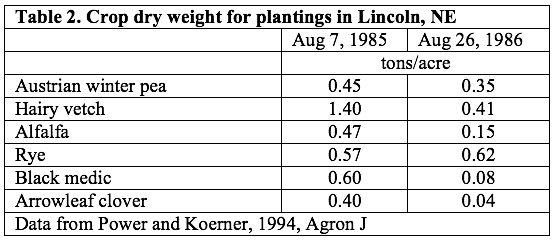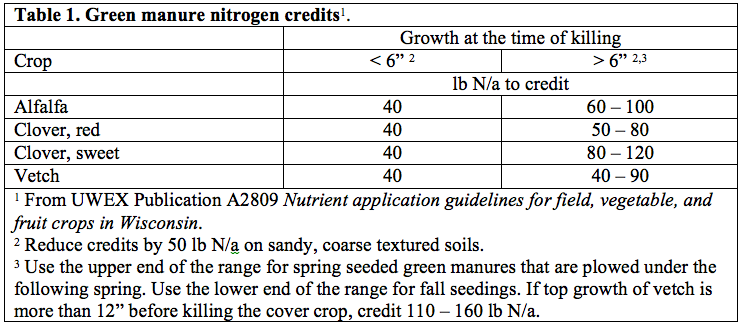space
Space
Late Summer Planting Legumes to Produce
Nitrogen Credits for Next Year
by Dan Undersander, Department of Agronomy
Carrie Laboski, Department of Soil Science
The high price of nitrogen fertilizer has increased interest in planting a legume crop after wheat or canning crop harvest as a green manure to provide some nitrogen credits for next year’s crop. This practice can provide some nitrogen and organic matter as well as increase ground cover to reduce erosion from fields. However, it may not be cost effective.
The following provides some data to help growers decide about options for producing nitrogen credits from late summer planted legumes.
How much nitrogen credits can we expect? The table 1 below shows the green manure nitrogen credits for several legumes. The nitrogen credit depends on the amount of crop growth and when the legume was planted. Nitrogen credits are 50 lb N/a lower on sandy, coarse-textured soils. Legumes other than those listed below would likely produce a range of N credits similar to those in table 1; however, not enough data exists on N credits to corn from these crops.
It is important to note that crops will perform differently from year to year depending on rainfall patterns, temperature and other considerations as shown by data from Power and Koerner (table 2). Thus the amount of fall forage dry matter production from August seeded legumes is highly variable from year to year depending on the specific pattern of rainfall and growing degree days, as well as the length of the fall period.
 If we then consider the seed cost (table 3) and seeding cost ($15 to $25/acre) the establishment cost of a legume (other than alsike) will be $32 to $69/acre. At nitrogen cost of nearly $1.00/lb, the legume would have to produce 32 to 69 lbs of nitrogen to break even with fertilizer cost. The economics of
If we then consider the seed cost (table 3) and seeding cost ($15 to $25/acre) the establishment cost of a legume (other than alsike) will be $32 to $69/acre. At nitrogen cost of nearly $1.00/lb, the legume would have to produce 32 to 69 lbs of nitrogen to break even with fertilizer cost. The economics of
planting a late summer seeded legume for nitrogen credits is questionable for most situations because there is no guarantee that at least a 40 lb N/a credit can be obtained.
There are two situations were where late summer seeded legumes may be beneficial. One is where a cover crop is needed to reduce erosion over winter. Any cover crop planted will have some cost so, for example if rye is generally planted as a cover crop, the seed cost is $15 to $20/bu rye this year. A legume could be planted for the ground cover at approximately the same cost and then the nitrogen fixed is a bonus. A better possibility may be to seed oats at ¾ to 1 bu/a oats along with the clover to provide rapid ground cover and still have some nitrogen fixing ability from the clover.
August seeding of legumes for nitrogen credits may also be valuable in organic systems where commercial fertilizer is not an option.
How to estimate value of legume green manure. Many who will plant a legume this fall must estimate the nitrogen credits next spring from the growth that occurred this fall. As shown above fall growth (and nitrogen fixation) is extremely variable. A simple method of getting a estimate of the nitrogen credits is to determine the yield of forage at frost this fall. Nitrogen credits come from both top growth and root growth. For perennials one can assume that half growth is above ground and half below. For annuals (like berseem, hairy vetch, and pea) one can assume that 60 to 70% of the total growth is above ground.
Thus, for perennials, determine the above ground growth and multiply by 2 to determine total biomass; then assume 3% nitrogen to determine nitrogen credits. For example, if a ton of forage is produced: assume 2 tons or 4,000 lbs total biomass times 3% = 120 lb nitrogen/acre.
For annual legumes, determine the above ground growth and multiply by 1.4 to determine total biomass; then assume 3% nitrogen to determine nitrogen credits. For example if a ton of forage is produced, assume 1.4 tons or 2800 lbs total biomass times 3% = 84 lb nitrogen /acre.
Actual nitrogen credits can be verified if the remainder of the N requirement for corn will be sidedressed next spring, then the pre-sidedress nitrate soil test (PSNT) can be used to verify N credits instead of using values from table 1.






